Cameroon
Things to DO
Rhumsiki
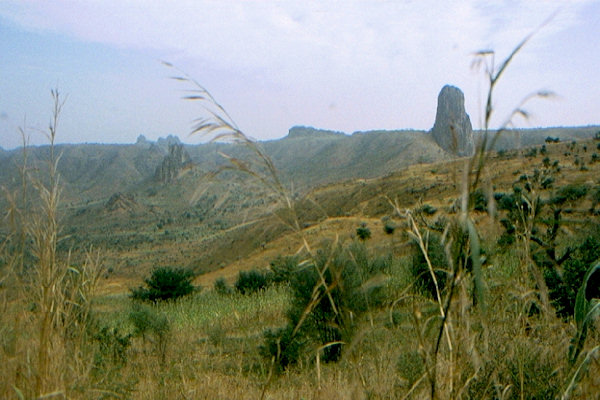 |
|||||
Rhumsiki is on all the tourist itinaries and is definitely over-run.
However, the surrounding countryside is beautiful and it's easy to leave Rhumsiki quickly behind and set out for the more unspoiled areas
on foot.
The inhabitants, members of the Kapsiki ethnic group, live in small houses built from local stone and topped with thatched roofs;
these homes are scattered throughout the village and surrounding valley.
Rising up from the valley, just before the village is the much fotographed Rhumsiki Peak. These fascinating rock formations were once
the molton cores of vulcanoes, wich cooled and hardened. The exterior of the vulcanoes have eroded away leaving these volcanic necks or
plugs, wich are composed of harder rock.
Foumban
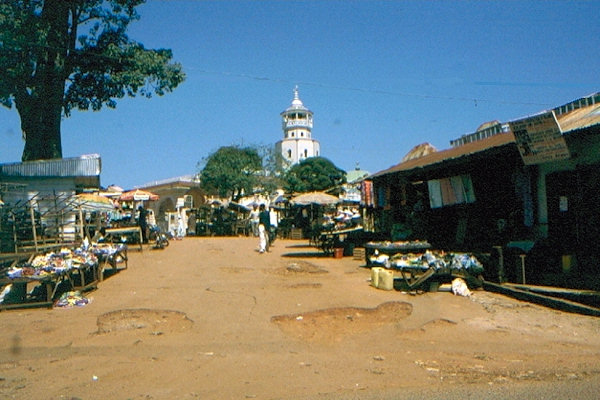 |
|||||
Foumban is a predominantly Muslim town center of the Bamoun people and a country highlight if you're interested in cameroonian
culture and artwork.
The Bamoun show allegiance to a single chief, the sultan, who is part of a dynasty dating to 1394. The palace was built in the early 20th
century by the 16th sultan, Ibrahim Njoya.
on the 1st floor is a hall of arms. The 2nd floor has a fascinating and well-organised museum containing previous sultans' possessions,
including royal gowns, instruments of torture, musical instruments, war garments and jewellery.
You can also see the journals and other writtings of Ibrahim Njoya, who developed his own alphabet, as well as schools to teach it.
This Shumom script, as it is known, is one of only a few alphabets in West Africa, and is still taught today.
Njoya also authored "Histories et Coutumes Bamoun" which continues to be one of the main repositiries of knowledge about Bamoun
traditions, and started his own religion in an effort to combine Christian, Islamic and Animist belief.
Kumba
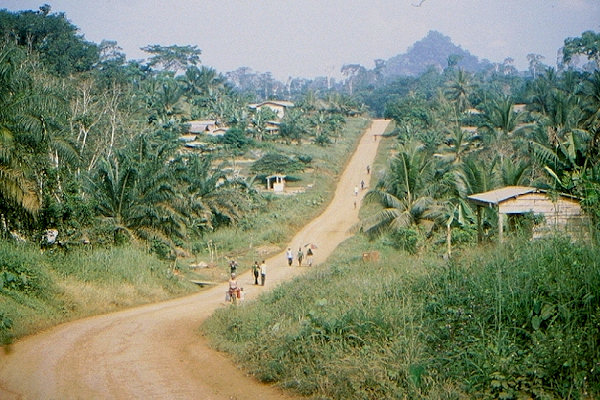 |
|||||
The area around Kumba is the most fertile part of Cameroon.
The major commercial source of the latex used to create rubber is the Para rubber tree, "Hevea brasiliensis". This is
largely because it responds to wounding by producing more latex.
Oil palms are grown for their clusters of fruit, which can weigh 40-50 kg. Upon harvest, the drupe, pericarp and seeds are used
for production of soap and edible vegetable oil.
Cacao is a small (4-8 m tall) evergreen tree cultivated throughout the tropics. Its seeds are used to make cocoa and chocolate.
Lake Barombi Mbo is a lake near Kumba.
It is located in the Cameroon volcanic chain, and is the largest volcanic lake in this region. These Crater Lakes are very old and
quite isolated. As a result, many species live in this ecoregion and nowhere else.
Korup National Park
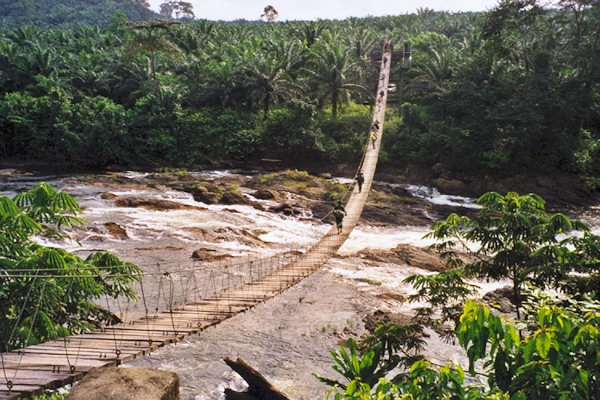 |
|||||
Korup National Park protects an exceptionally biologically diverse patch of rainforest reported to be one of the oldest and
richest in Africa.
Within its 1.259 sq. km are more then 300 species of bids, 50 species of large mammals, more than 400 varieties of trees and over 90
medicinal plants.
The vegetation is very dense and - apart from monkeys - you're unlike to see animals, but visiting is a superb way to experience a
rainforest ecosystem.
Korop is also the easiest of Cameroon's protected rainforest areas to reach, and one with the most developed infrastructure. There is
more than 100km of marked walking trails within the park, well-trained English-speaking guides, and enough to keep you busy for at least
two days.
The entrance is via the famous suspension bridge that crosses the Mana River.
Buea
Buea, on the lower slopes of Mt Cameroon, is a large, sprawling town and the starting point for climbing the
mountain. From 1901, it was briefly the German colonial capital.
Mnt Cameroon (4.095m), known localy as "Fako", is West Africa's highest mountain and one of it's active volcanos.
Mt Cameroon had eruptions in 1999 and 2000. Biologically, it is of great interest for its endemic plants and birds, and for the unique
climatic conditions that make it a biodiversity "Hot spot".
Although it is so close to the sea it can rarely be seen from the coast as clouds gather round its lower slopes and Debuncha at its
southwest corner is reputed to be the second wettest place in the world.
There are several routes to the top and numerous trails on the mountain's lower slopes. None require technical equipment, but warm clothes
are essential near the summit and waterproof gear is advisable.
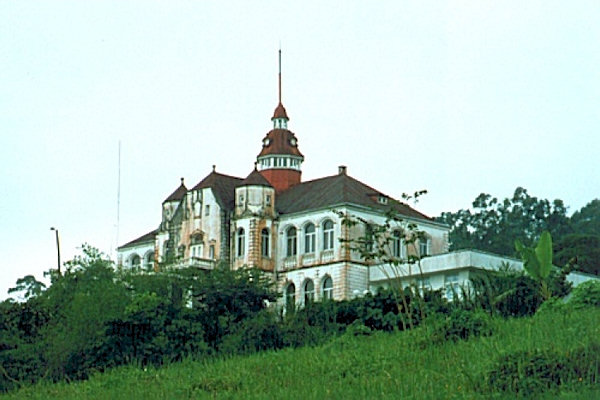 |
|||||
The quickest is the "Guinness Route" (Indicated yellow on the map), a straight up-and-down climb that can be done in two days,
though it's quite steep in parts.
Along the Guiness Route are three poorly maintained huts (at 1.875m, 2.869m and 3.740m) with plank beds and little else.
The best way to organise a climb is through the Mt Cameroon Ecotourism Project, in Buea, a highly professional local organisation
comitted to sustainable tourism. It works closely with village communities, many of whose inhabitants work as guides and porters.
I did climb the mountain; see my Climbing Mt Cameroon pages for the story.
The Mt Cameroon Race ("Race of Hope") is held annualy in February, and attracts an international group of competitors and
many spectators. Competitors use the Guiness Route to reach the summit, with the winners usualy finishing the approximately 40km course,
up and down, in an amazing 4 1/2 hourse for men and 5 1/2 hours for women.
Kribi
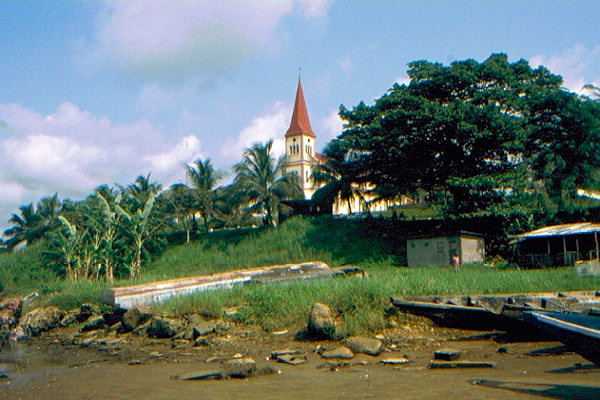 |
|||||
With its attractive beaches and good road access, Kribi has become Cameroon's main beach resort and favoured weekend
getaway for Government ministers and Douala expats.
It also experienced a development boom in recent years, with the construction of the Chad-Cameroon oil pipeline, witch will terminate
just to the south.
While you won't find the turquoise waters here that mark East Africa's coastal areas, the beaches make a relaxing break from the rigours of
the road.
Most beaches are ideal for swimming, although check locally before plunging in as currents can be strong at times.
At the south-side is a harbour with local fisherman selling there catch.
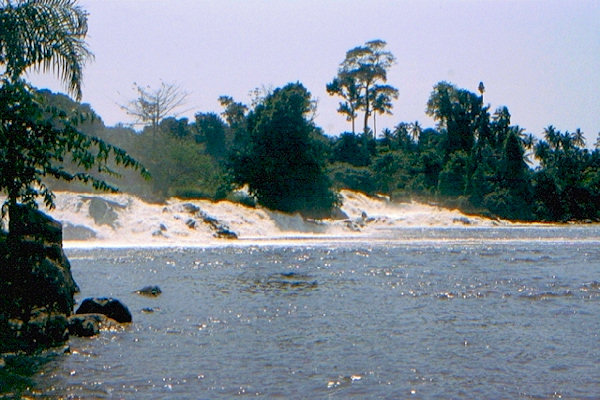 |
|||||
About 8 km south of Kribi are the picturesque, but commercialised Chutes de la Lobe (Lobe waterfalls) witch are
reputed to be among the world's few falls flowing directly into the sea.
Near the Lobe falls you will besieged with offers to take a progue to see "Pygmy Villages" upstream on the Lobe river.
While the Pygmy villages are overrated and without much authencity, the boat ride itself is worthwile just to experience the river
and vegetation.